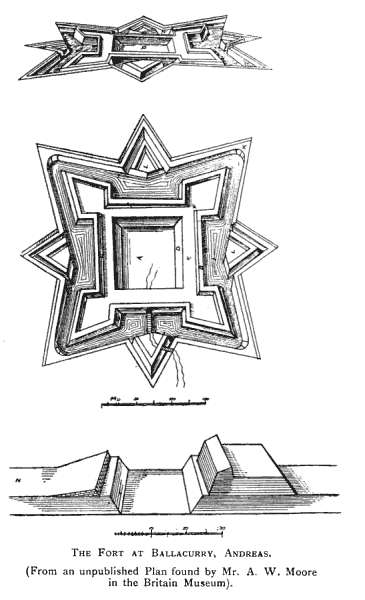
[From Proc IoMNHAS vol 1]
OCTOBER 17, 1907.
Leader—Mr. P. M. C. Kermode, President.
Notwithstanding a drenching mist, alternating with heavy rain, a quorum of members assembled at Ballaugh on Thursday, 17th October, for the third excursion of the season. The following were present during the day :—His Excellency Lord Raglan, Hon. President ; Messrs. P. M. C. Kermode, President ; G. Patterson. Vice-President ; T. E. Acheson, and J. C. Crellin and Mrs. Crellin also as visitors—Mr. Norman Grey, the Hon. FitzRoy Somerset, the Hon. Georgiana Somerset, Mr. E. C. Farrant.
Leaving Ballaugh Railway Station at 11 30 a.m., the party drove to Cronk Ould, where they were received by Mr. W. H. Corlett, who conducted them across the fields to the circular earth-work known as Cashtal Lager, on the slope of the hill above the house, in a position which commands a view of the coast and northern plain from the Point of Ayre to Bishop’s Court
The leader stated that in his list of Manx Antiquities, published in 1900, he had mentioned about sixty forts and camps scattered throughout the Island, from two to five in every parish. These were of five or six distinct types, and belonged, evidently, to as many different periods. The present example was of the type met with at St. Mark’s, Malew, and of one, now entirely disappeared, which had formerly been on the broogh near the mouth of Ballure Glen, Ramsey. It was not one of the earliest, but he was not at present prepared to assign a date to it.
Returning to the carriage, the road was taken to Sulby, but as there was no sign of the weather clearing, it was decided not to climb Knock Sumark, now generally known as Primrose Hill, on the summit of which is a " hill fort " of earlier type than the last. Members had brought luncheon with them, but agreed that a room in the Ginger Hall would be a more comfortable place for a picnic than the summit of the hill. After lunch they proceeded to Ballacurry, where they were hospitably received by Mr. and Mrs. Crellin. Mr. Crellin conducted them to the large and well-preserved 17th century fort, which was examined with great interest. This has been fully described in vol. V. of the Manx Society publications ; it was probably erected about 1640, by James, seventh Earl of Derby, and never occupied. Indeed, it now appears from a plan of it, which had recently been found by Mr. A. W. Moore in the British Museum, that it had not even been completed.
Returning to the house, where they were received with a hearty welcome by Mrs. Crellin, who entertained them to afternoon tea, a short meeting of the Society was held, at which the Governor took the chair, and there were also present : Messrs. P. M C. Kermode, J. C. Crellin, G Patterson, T. E. Acheson, and Norman Grey. ...

EXPLANATION OF PLATE.
The new worke being a regular fortification.
A—The inner parte of ye Forte.
B—The Rampier.
C—Tales on the out sid.
D—Tales on the in sid.
E—Rampier a burfe.
F—Font Step.
G—The baston.
Plan of Fortification.
G—The Brancket.
H—Tales of the Diche.
1—Diche.
K—Counterscarpe.
L—The out works.
M—The scale, being 150 paces.
N—The Profeele.
O-—The scale.
P—The E forte innperstitue (sic).
There are also sketches of several small star-shaped Forts headed,"these being severall Forts for Presieents (sic)
|
|
||
|
Any comments, errors or omissions
gratefully received MNB
Editor |
||